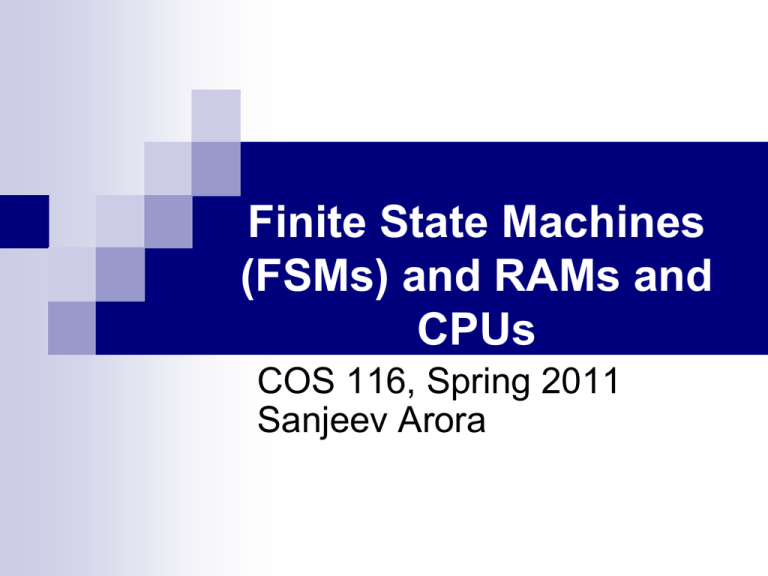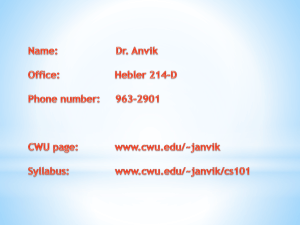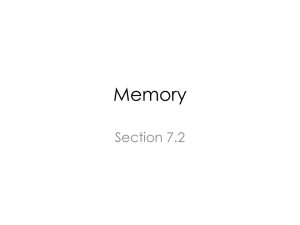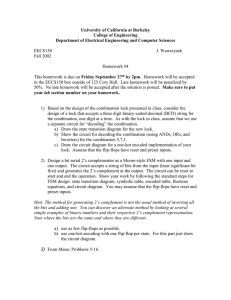Finite State Machines (FSMs) and RAMs and CPUs COS 116, Spring 2011
advertisement

Finite State Machines (FSMs) and RAMs and CPUs COS 116, Spring 2011 Sanjeev Arora Recap • Combinational logic circuits: no cycles, hence no “memory” • Sequential circuits: cycles allowed; can have memory as well as “undefined”/ambiguous behavior • Clocked sequential circuits: Contain D flip flops whose “Write” input is controlled by a clock signal Recap: R-S Latch S R M Forbidden to turn on both Set and Reset simultaneously (value is “ambiguous”) Recap: D Flip Flop Basic Memory Block – stores 1 bit. D M W If we “toggle” the write input (setting it 1 then setting it 0) then M acquires the value of D. “Timing Diagram” D M W 5V D 0V 5V Time W 0V 5V Time M Output appears when W becomes 0 again. 0V Time Finite State Machines (FSMs) “Automatic Door” Detected Person No Person Detected Closed Open Detected Person No Person Detected Finite number of states Machine can produce outputs, these depend upon current state only (“Moore machine;” see Hayes article) Machine can accept one or more bits of input; reading these causes transitions among states. Implementing door FSM as synchronous circuit No Person Detected Person Detected Open Closed Detected Person INPUT No Person Detected 0 = No Person Detected 1 = Person Detected Input Present State STATE 0 = Door Closed 1 = Open Next State 0 0 0 1 0 1 0 1 0 1 1 1 Implementation of door FSM (contd) 0 = No Person Detected 1 = Person Detected INPUT D M CLOCK W STATE 0 = Door Closed 1 = Open Implementation: General Schematic State Circuit to compute next state CLK Inputs Flip flops (memory elements that hold “state”) K Flip flops allow FSM to have 2K states Circuit to compute outputs Discussion Time Example: 4-state machine; 1 bit of input; 1 bit of output State variables: P, Q Input variable: D Next value of P = (P + Q) D Next value of Q = P Output = P Q What is its state diagram? How can it be implemented as a clocked synchronous circuit? Divide in groups of 3 and hand this in. How to implement a FSM? •If number of states = 2k then represent “state” by k boolean variables. •Identify number of input variables • Write truth table expressing how “next state” is determined from “current state” and current values of the input. Convert to boolean circuit. •Express as clocked synchronous circuit. How an FSM does “reasoning” “If left infrared sensor detects an object, turn left” L=1 L=0 T= 0 T =1 Output goes to motor that turns the wheel Next…. Random Access Memory (RAM) Memory where each location has an address Recall from last lecture: “Register” with 4 bits of memory How can you set up an addressing system for large banks of memory? RAM Data Data K Address Bits RAM RAM K Address Bits Read Write 2K bits; bank of flipflops If 4 locations, “address” has 2 bits Address Clock To RAM’s “Clock” input RAM: Implementing “Write” Data Decoder (Demux) Clock RAM The decoder selects which cell in the RAM gets its “Write” input toggled (simple combinational circuit; see logic handout) K-bit address (in binary) Ram: implementing “Read” Data Multiplexer RAM The multiplexer is connected to all cells in the RAM; selects the appropriate cell based upon the k-bit address (simple combinational circuit; see logic handout) K-bit address (in binary) Next, the secret revealed... How computers execute programs. CPU = Central Processing Unit Scribbler Control Panel Program Machine Executable Code F5 “Download to Robot” (Compilation) Similar to: Point 1: Programs are “translated” into “machine language”; this is what’s get executed. •T-P programs represented in binary • .exe files in the Wintel world Greatly simplified view Program (in binary) of modern CPUs. stored in memory Memory Registers Arithmetic and Logic Unit (ALU) Control FSM Instruction Pointer RAM Lots of Custom Hardware Examples of Machine Language Instructions ADD 3 7 12 Add contents of Register 3 and Register 7 and store in Register 12 LOAD 3 67432 Read Location 67432 from memory and load into Register 3 JUMP 4 35876 If register 4 has a number > 0 set IP to 35876 Stored in binary (recall Davis’s binary encoding of T-P programs) Different CPUs have different machine languages Intel Pentium, Core, Xeon, etc. (PC, recent Mac) Power PC (old Mac) ARM (cellphones, mobile devices, etc.) “Backwards Compatibility” – Core 2’s machine language extends Pentium’s machine language Machine languages now allow complicated calculations (eg for multimedia, graphics) in a single instruction Main Insight Computer = FSM controlling a larger (or infinite) memory. Meet the little green man… The Fetch – Decode – Execute FSM Decode Fetch Execute Fetch – Decode – Execute FSM IP IP + 1 “Fetch” Decode Execute (output bits used to control circuits that add, multiply etc.) Go to next instruction CPU as a conductor of a symphony Network Card CPU Sound Card “BUS” e.g., PCI CD-ROM Video Card Bus: “Everybody hears everybody else” Speculation: Brain as FSM? • Network (“graph”) of 100 billion neurons; each connected to a few thousand others • Neuron = tiny Computational Element; “switching time” 0.01 s • Neuron generates a voltage spike depending upon how many neighbors are spiking.



